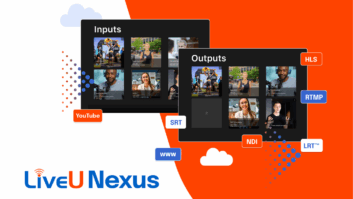Satellite transmission has been a pivotal innovation for the broadcast sector. Since The European Space Agency (ESA) first enabled test transmissions from its Orbital Test Satellite, the technology has revolutionised TV and delivered a wide range of content to global audiences. Today, satellite technology is so ubiquitous and so seamlessly integrated into daily life, that consumers don’t actively notice until there is an issue or a disruption in service.

Competition on the horizon
As with many established technologies, the geo-stationary satellite industry is suffering from an image problem and is currently facing fierce competition from a series of disruptive technologies. Low Earth Orbit (LEO) satellites might be related to GEO, but they are not universally seen as a welcome addition to the family. The Starlink project has deployed vast constellations of mesh architecture satellites, to provide high-speed internet access at altitudes much closer to the Earth’s surface. Whilst not a direct challenger, LEO is changing the landscape for internet-based content delivery, enabling access to high-speed internet in regions where traditional infrastructure has previously been lacking.
As fibre optic networks become more widespread, they also help more consumers gain access to reliable, high-bandwidth connections that can compete with satellite broadcasts. Internet Protocol Television (IPTV) uses broadcast quality transport protocols, such as RIST and SRT, to deliver secure, low-latency video content. Contribution and distribution can be dynamically scaled to multiple stream destinations, without losing the quality of a single stream. Broadcast IP technology has become increasingly sophisticated in recent years, with next-generation software-defined encoders and decoders, as well as advanced cloud orchestration capabilities. Add to this the rollout of 5G networks enabling high-speed data transmission, and the pressure on traditional satellite operators has been mounting.
Develop or decline
Broadcast satellite infrastructure is, of course, still integral to global content delivery. But with the growing demand for satellite capacity, spectrum congestion has been on the rise. To combat this, satellite operators have been working on spectrum efficiency technologies. Using advanced modulation techniques and signal processing methods that use the available spectrum more efficiently and transmit more data. Satellite operators have also been collaborating with regulatory bodies and other operators, to coordinate frequencies and participate in spectrum-sharing arrangements that reduce interference.
Satellite operators have recognised the need to invest in developing more advanced systems, which can perform in narrower frequency bands or use higher frequencies to reduce congestion in specific bands. Next-generation satellite systems are now equipped with flexible frequency reuse capabilities. These utilise adaptive resource management techniques, to dynamically allocate resources based on demand, optimising the use of available spectrum.
Finding the right fit
With the broadcast industry’s competitive landscape evolving so rapidly, leveraging the strengths of both IP and satellite technology will prove crucial for success. Hybrid models that combine satellite and IP effectively, can help to balance capacity, manage tight budgets, and optimise latency to achieve the best of both worlds. This approach is all about implementing the right technology for the relevant use case.
More than ever, resource-strapped content owners need end-to-end solutions, so they can be sure of implementing the optimum broadcast technology for their needs – without redeploying a network for every match or live event. This necessitates a collaborative relationship between IP technologists and satellite evangelists, to identify the unique advantages of each technology for live delivery.
A mix and match strategy
Satellite infrastructure is the obvious choice when planning widespread coverage for global broadcasts. It allows content owners to reach a vast audience, spanning continents with a single satellite. But there are still areas which fall outside of its footprint. In these instances, rather than using multiple satellite hops, the agility of IP comes into play by helping to cost-effectively plug any gaps. IP-based broadcasting allows for scalability, making it easier to expand services to varying audience sizes and geographical locations, using spin-up and spin-down setups.
Live sports broadcasting demands minimal latency for real-time viewing, so maximising IP’s capabilities can be a gamechanger. Utilising satellite for its reliability in delivering high-resolution content, and IP for efficient distribution, strikes a perfect balance between high-quality, low-latency delivery. In areas where broadcasts might be susceptible to extreme weather conditions, using IP and satellite in conjunction guarantees uninterrupted content delivery for high-value events. Developing redundancy plans that incorporate both satellite and IP ensures continuity of service, as in the case of disruptions in one system, the other serves as a backup.
IP delivery was built for a digital world and is therefore king when it comes to interactive, on-demand, or personalised content experiences. IP-based broadcasting enables interactive features and viewer engagement tools, with detailed analytics and audience measurement functionality. Broadcasters can gather data on viewer behaviour, preferences, and engagement, which supports content customisation and targeted advertising. Alongside this, the growing interest in high-definition and 4K/8K content, means that the supporting bandwidth requirements are escalating. But combining satellite’s broad coverage, with the bandwidth capabilities of 5G networks can help to alleviate this pressure. These are just a few examples of how broadcast IP can help satellite operators respond to changing consumer demands and new viewing dynamics.
By embracing collaboration between traditional satellite broadcast and evolving IP delivery technologies, the industry can create a more robust and adaptable ecosystem that meets the demands of consumers and content owners alike.






